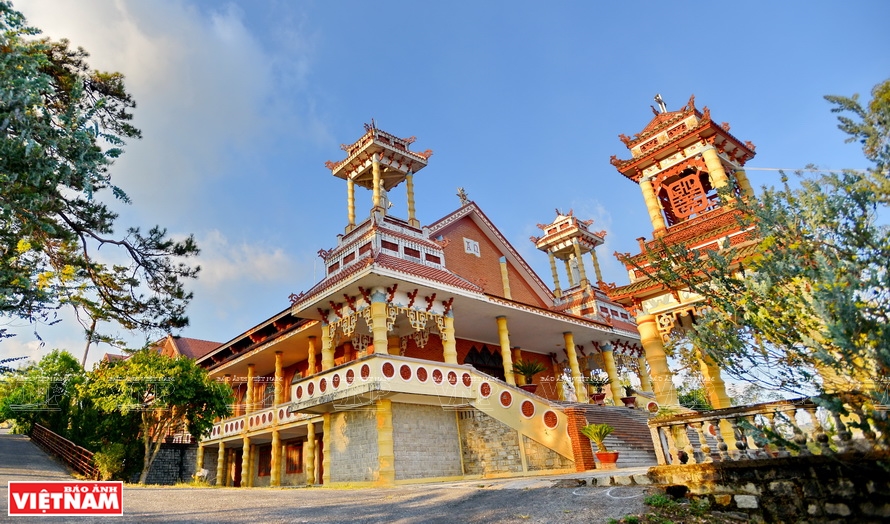As Catholic churches go, Du Sinh church in Da Lat has architecture that might not be seen anywhere else. That peculiarity does not only serve as a tourist magnet but also reflects the fascinating cultural and religious life of the Vietnamese people.
Du Sinh church was built in 1956 and inaugurated on Christmas of 1957, except for the bell tower which was completed in 1962. Overall, the exterior of Du Sinh church is indeed similar to a Vietnamese temple. The church is located on a hill on Huyen Tran Cong Chua street in Da Lat city. The church’s gate is built with three doors and a simple structure. From the gate to the cathedral there is a ramp divided into 5 levels. A pair of giant cement dragons lie in wait from the bell tower floor to the gate.

Du Sinh church in Da Lat has architecture that might not be seen anywhere else. Photo: Thanh Hoa/VNP
|
The bell tower sits in front of the cathedral, with a shoe-shaped tile roof that curves upward at each of the four corners. At its two sides are two towers that were constructed in the same style and hold holy statues. These towers form another three-point structure next to the three-door gate.
The cathedral itself is a large two-story building with brick walls and a red tile roof in traditional style. Outside, there are two long corridors running along both sides of the house. All large columns in the hallway and inside the cathedral are covered with bamboo decorations, evoking a nostalgic feeling of Vietnamese villages. The surrounding corridors are decorated with circular cells in the shape of the “Tho" character (longevity), a decoration regularly seen in Vietnamese temples and pagodas.
Another unique characteristic of Du Sinh church is the use of the dragon image in a Catholic church. The most interesting thing is that not only do dragons appear, they take on unexpected variations. For example, in the traditional architecture of Vietnamese palaces, communal houses and pagodas, “two dragons adore the moon” is a popular decoration to denote reverence and devotion to the gods. That pattern, when it appears on the gate of Du Sinh church is modified to, “Two dragons adore St. Joseph holding Baby Jesus”.
It is believed by many that this type of East-West architecture comes from the ideas and desires of the chief architect, who is said to be the "soul" of Du Sinh church, Bishop Buu Duong. He belonged to the royal lineage of the Nguyen Dynasty, was the fifth direct nephew of King Minh Mang and a firm believer in Buddhism. Before becoming a Christian, he studied at a Buddhist temple, was fluent in Han Nom characters and was well-versed in Eastern culture and philosophy. The one-of-a-kind architecture of Du Sinh church is believed to have been born under the strong and deep influences of this culture, education and family background.
By Thanh Hoa - Translated by Hong Hanh